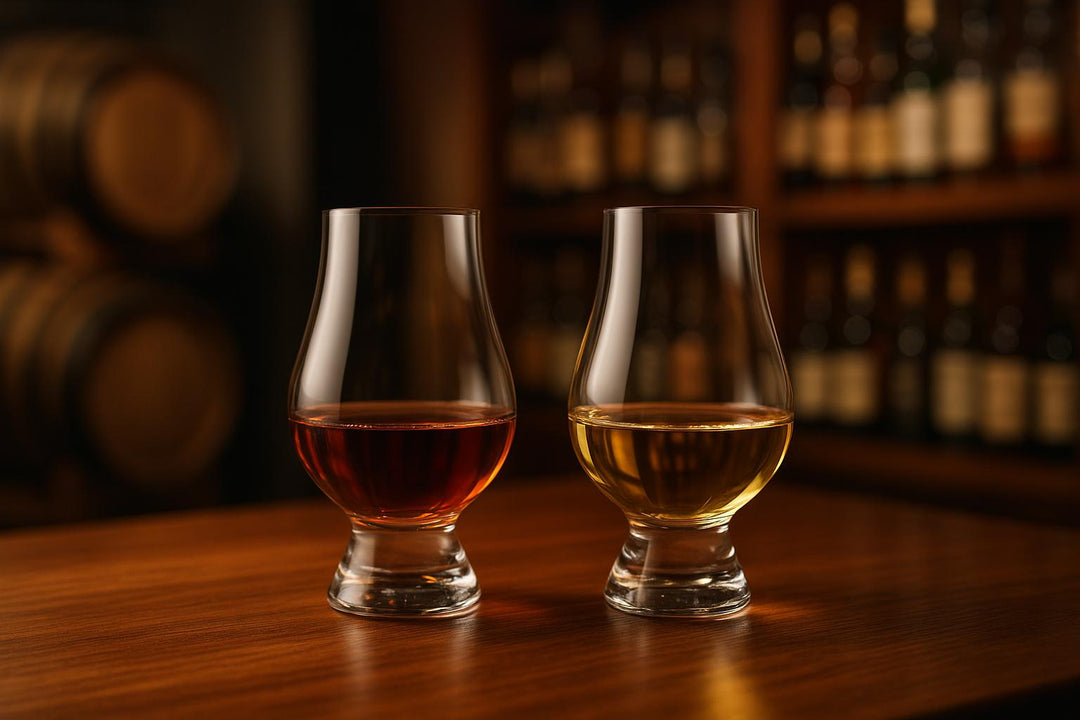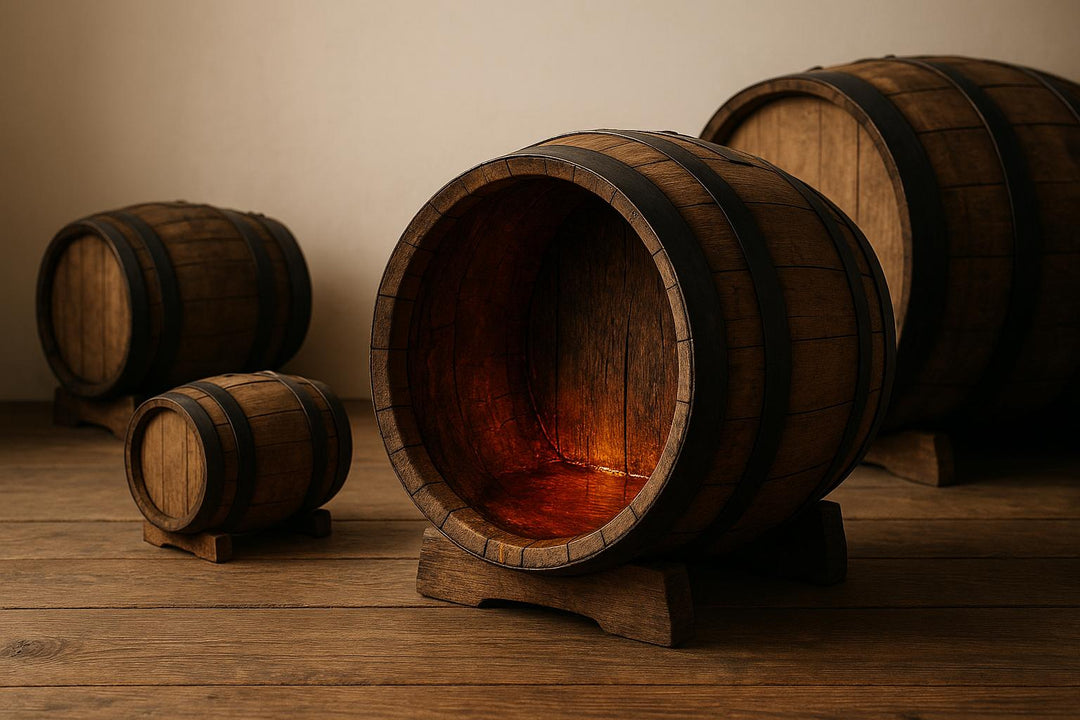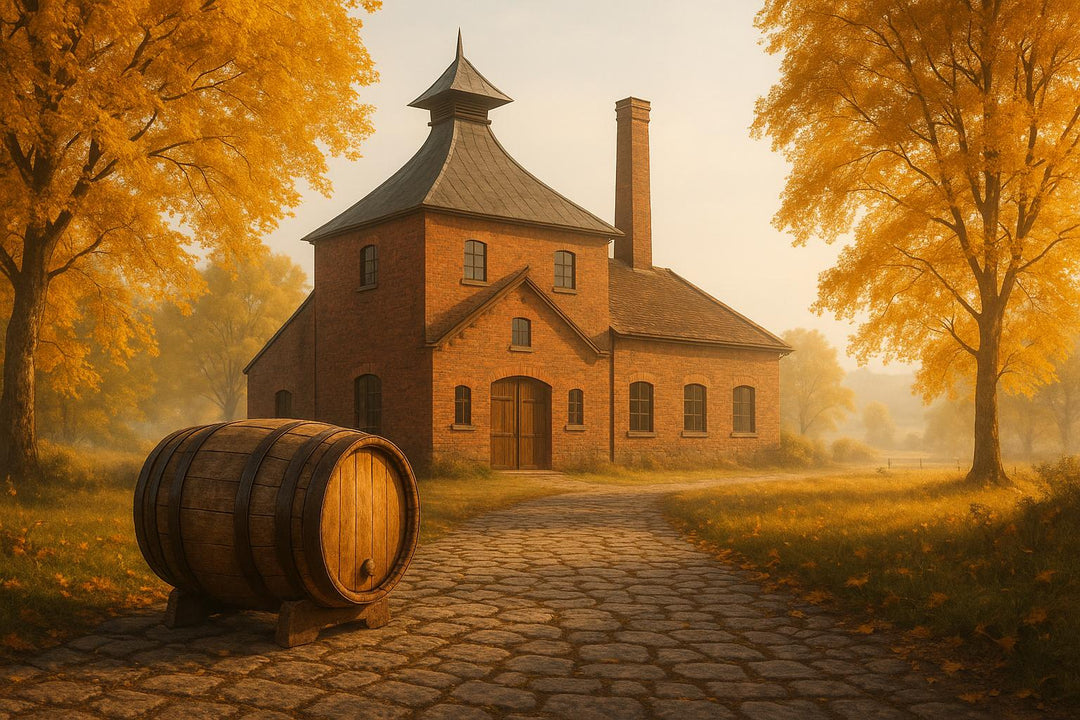Whisky ages differently depending on the climate. Hot climates speed up the process, creating bold, intense flavours in fewer years, while cold climates slow it down, allowing for subtle, balanced profiles over decades. Here’s what you need to know:
-
Hot climates (e.g., Taiwan, Texas):
- Faster maturation due to high temperatures.
- Higher evaporation rates (8–12% annually).
- Strong oak interaction with flavours like caramel and spice.
- ABV often increases as water evaporates faster.
-
Cold climates (e.g., Scotland):
- Slower maturation for refined complexity.
- Lower evaporation rates (2–3% annually).
- Gradual flavour development with fruit and floral notes.
- ABV tends to decrease as alcohol evaporates faster.
Quick Comparison
| Factor | Hot Climate | Cold Climate |
|---|---|---|
| Maturation Speed | 3–8 years | 12–30+ years |
| Evaporation Rate | 8–12% annually | 2–3% annually |
| Flavour Notes | Bold, intense | Subtle, balanced |
| ABV Change | Often increases | Often decreases |
Whether you prefer bold whiskies from warmer climates or the nuanced elegance of cooler-aged spirits, the environment shapes every sip.
I Compared Elijah Craig Barrel Proof C923 to Cask Strength Texas Whiskey

Whisky Aging in Hot Climates
Whisky maturation in hot climates is a whirlwind process, creating bold and intricate flavours in a fraction of the time it takes in cooler regions. The higher temperatures speed up the ageing process, producing whiskies that stand apart from their traditionally matured counterparts.
Faster Aging and Oak Interaction
In hot climates, whisky matures at a much quicker pace. For every 18°F (about 10°C) increase in temperature, chemical reactions double, allowing the spirit to absorb flavour compounds like vanilla, caramel, and spice much faster[3]. Ian Thomas, Distillery Director at Virginia Distillery Co., explains this phenomenon:
"If you compared two 3-year-old whiskies made in a similar way but aged in two different climates - one cool and steady, one warm with big temperature swings - you would see more development and exchange of fatty acids, tannins, vanillins, and other maturation components in the warmer climate, leading to a more robust flavour profile." [3]
The dramatic temperature swings between day and night in warm regions also create a 'breathing effect,' pushing the whisky deeper into the oak barrels. This interaction intensifies the extraction of oak-derived flavours, resulting in a richer colour and pronounced oaky notes. The quicker extraction process not only amplifies the flavour but also sets the stage for noticeable evaporation effects.
Evaporation and Volume Loss
Hot climates come with a trade-off: higher evaporation rates, often referred to as the 'angel's share.' In Scotland, distilleries typically lose around 2–3% of whisky annually to evaporation, but in warmer climates, the losses are significantly higher.
At Kavalan Distillery in Taiwan, for instance, about 12% of the whisky evaporates from each barrel every year[3]. This volume loss can have a significant impact on production costs. In regions like Kentucky and Texas, the hot, dry conditions cause water to evaporate more quickly than alcohol, leading to an increase in alcohol by volume (ABV)[7]. This concentration effect not only boosts the whisky's strength but also enhances its flavour, allowing distilleries to achieve impressive complexity in a shorter time.
Rich Flavours from Warm-Climate Maturation
The combination of accelerated evaporation and intensified oak interaction creates whiskies with bold, complex flavours. Hot climates draw out flavour compounds from the wood more quickly, resulting in pronounced notes of caramel, vanilla, and spice - flavours that would take much longer to develop in cooler environments.
Andy Watts, Master Distiller at James Sedgwick Distillery, highlights the impact of warm conditions:
"Whisky matured in warm conditions does tend to mature quicker due to the accelerated interaction between spirit, cask, and air, resulting in a whisky that portrays itself as smoother and softer at a young age." [3]
Taiwan’s subtropical climate offers a prime example of this rapid ageing process. Ian Chang, Master Blender at Kavalan Distillery, describes how the local environment transforms their whisky:
"We find the warm temperature significantly speeds up the maturation process. The heat of Taiwan's subtropical climate and the humidity in Yilan speed up the chemical reactions between the oak barrel and the new-make spirit, which shortens the maturation process. It enables us to develop a rich and complex whisky in just a few years." [3]
This accelerated maturation allows whiskies aged for a short time to achieve the depth and complexity typically associated with much older spirits. The deeper penetration of the spirit into the wood also results in darker colours and a more pronounced oaky character[1]. The constant expansion and contraction within the cask ensures maximum extraction of both colour and flavour, delivering a whisky with a bold and distinctive profile.
Whisky Ageing in Cold Climates
Cold climates offer a unique setting for whisky maturation, where patience becomes a virtue. In places like Scotland, the cooler temperatures create a slower, more deliberate ageing process, resulting in refined and carefully developed spirits.
Slow Maturation and Subtle Oak Interaction
In colder environments, whisky matures at a much slower pace, allowing flavours to evolve gently over time. The cooler temperatures slow down the chemical exchanges between the spirit and the oak barrels, preserving the whisky's natural character while gradually adding layers of complexity.
Temperature shifts in chilly warehouses cause the whisky to interact with the wood at a more measured rate. This slow process often brings out lighter, fruit-forward notes, complemented by floral and soft spice undertones [1]. The gradual rhythm of maturation ensures the whisky retains its unique essence while developing a balanced and intricate profile [5].
Reduced Evaporation and Better Volume Retention
One major benefit of ageing whisky in cooler climates is the lower evaporation rate, often referred to as the "angel's share." In places like Scotland, where the climate is cool and humid, evaporation is significantly reduced compared to warmer regions [4].
In these conditions, alcohol evaporates more quickly than water, causing the ABV (alcohol by volume) to decrease slowly over time [7]. This natural process softens the whisky, contributing to the smoothness that is characteristic of spirits aged in such environments. Additionally, the lower evaporation rate helps distilleries minimise product loss, ensuring more of the whisky is retained for bottling [4]. This extended maturation period allows for a gradual build-up of complexity [5].
Elegant Flavours from Cold Climate Ageing
Whiskies aged in cold climates are celebrated for their refined and elegant flavour profiles. The slower maturation process encourages the development of smooth, nuanced notes, often featuring a delicate mix of fruit, floral, and gentle oak characteristics [7].
This steady interaction between the spirit and wood leads to a whisky that is both subtle and complex. Bottles from these regions often showcase a harmonious blend of soft fruit and spice, making them highly sought after by enthusiasts.
The extended ageing periods made possible by cold climates allow whiskies to fully mature and achieve the sophisticated depth of flavour that has long been associated with premium Scotch whiskies.
sbb-itb-128d6c1
Hot vs Cold Climate Ageing: Key Differences
The ageing process of whisky in hot and cold climates creates vastly different results. Everything from how quickly the spirit matures to its final flavour profile is shaped by the environment, making climate a crucial factor in whisky production. These variations not only impact taste and alcohol strength but also determine how long the whisky needs to age before it’s ready.
The speed of maturation is one of the most noticeable differences. In warmer climates, whisky matures faster due to heightened interaction between the spirit, the cask, and the surrounding air. This means whiskies from hot regions can develop complexity in much less time compared to their cooler-climate counterparts.
For example, whiskies aged in warmer environments with significant temperature fluctuations often exhibit noticeable development of fatty acids, tannins, and vanillins. This results in bold and robust flavours that contrast with the more delicate profiles found in whiskies aged in cooler, stable conditions.
Evaporation rates also vary significantly. At Taiwan's Kavalan Distillery, for instance, the annual evaporation loss can reach 12%, compared to just 2-3% in Scotland [3]. This higher loss not only increases production costs but also concentrates the flavours more quickly.
The changes in alcohol content (ABV) further highlight the climate divide. In hot, dry regions like Kentucky or Texas, water evaporates faster than alcohol, often causing the ABV to rise over time [7]. On the other hand, Scotland’s cool, humid environment leads to alcohol evaporating more readily, which gradually lowers the ABV as the whisky matures [7].
Climate Comparison: Hot vs Cold Ageing Factors
Here’s a quick breakdown of how hot and cold climates impact whisky ageing:
| Factor | Hot Climate | Cold Climate |
|---|---|---|
| Maturation Speed | Faster (3-5 years typical) | Slower (10-25+ years common) |
| Annual Evaporation Rate | 8-12% (e.g., Taiwan) | 2-3% (e.g., Scotland) |
| Flavour Development | Bold and intense, with strong oak influence | Subtle, balanced, and delicate complexity |
| ABV Changes | Often increases (water evaporates faster) | Often decreases (alcohol evaporates faster) |
| Temperature Fluctuations | Large swings cause rapid cask interaction | Steady conditions allow slower, gentler interaction |
| Typical Ageing Period | 3-8 years for full maturity | 12-30+ years for premium whiskies |
Take Taiwan’s subtropical climate as an example. The warm temperatures and high humidity there speed up the chemical reactions between the spirit and the oak barrels, producing rich and complex whiskies in just a few years [3].
This contrast in maturation speed explains why whiskies from regions like Kentucky and Texas are often aged for only a few years, while Scotch whiskies may spend decades in casks [7]. The climate doesn’t just influence the flavours - it shapes the entire production process.
Other Factors That Influence Whisky Aging
While temperature plays the leading role in whisky ageing, factors like humidity and air pressure also shape the spirit’s final character. These environmental influences explain why whiskies from the same distillery can develop distinct flavours based on their storage conditions.
Humidity and Air Pressure Effects
Humidity directly impacts the evaporation process, which is crucial for flavour development. Distillers often aim for a relative humidity of 60–70% to achieve balanced maturation[1]. In warmer climates, higher humidity encourages the oak to release more flavour compounds, often resulting in a darker whisky with stronger wood notes[1]. On the other hand, in cooler climates, excessive humidity can lead to over-ageing, producing an overwhelming woody taste[8]. Lower humidity levels, meanwhile, concentrate the whisky’s flavours but reduce the overall yield due to increased evaporation[1].
Air pressure fluctuations also play a part in whisky maturation. When pressure drops, the whisky is pushed deeper into the wood, allowing it to absorb and then release more extracted flavours[2]. Regions with significant pressure variations often produce whiskies with greater complexity[2]. Jared Himstedt, head distiller at Balcones, highlights how barometric changes influence the process:
"A crisp, cold September will push more flavour back out as the cask contracts – like squeezing a sponge"[7].
Higher atmospheric pressure can also affect distillation by delaying cut points, which alters the balance of volatile and desirable compounds in the final product[6].
These nuanced environmental factors encourage distilleries to refine their ageing techniques to optimise flavour.
How Distilleries Adapt to Climate
To tackle these climatic challenges, distilleries have developed innovative storage and barrel management methods. Techniques like strategic barrel rotation and climate-controlled warehouses allow distilleries to take advantage of local conditions while maintaining consistent maturation[1]. Although climate-controlled facilities can be expensive, they provide precise control over temperature and humidity, ensuring predictable results[8][10].
In hot, humid areas, some distilleries use thicker barrels to slow down the ageing process, while others opt for smaller barrels to speed it up without sacrificing quality[8]. Many facilities are also leaning into sustainable practices to improve efficiency and reduce environmental impact[10]. Additionally, the choice between traditional dunnage warehouses with earthen floors and modern racked warehouses reflects how each distillery adapts to its unique environment[9].
Conclusion: Understanding Climate's Role in Whisky Character
As we've explored, climate plays a pivotal role in shaping the personality of whisky, turning the same spirit into a variety of distinct expressions.
Warmer climates speed up the maturation process, resulting in bold and concentrated flavours at a younger age. Andy Watts, master distiller at James Sedgwick Distillery, explains it well:
"Whisky matured in warm conditions does tend to mature quicker due to the accelerated interaction between spirit, cask, and air, resulting in a whisky that portrays itself as smoother and softer at a young age" [3].
This rapid maturation often brings forward robust fruit notes and pronounced oak characteristics. For example, Balcones in Texas produces richly coloured, spicy whiskies in as little as two years [3].
On the other hand, whiskies aged in cooler climates take their time, allowing for a more gradual development of flavours. This slower process results in delicate, layered profiles that gently evolve over time, often requiring years to fully mature and reveal their complexity.
For whisky lovers, this diversity in ageing climates offers a chance to experience two very different approaches to maturation. Taiwan's Kavalan distillery showcases the intense flavours that come with tropical ageing, while Scottish whiskies highlight the refined elegance achieved through patient, cool-climate maturation. Each style has its own charm - whether it’s the bold intensity of a young, warm-climate whisky or the intricate depth of a slow-aged, cool-climate creation.
The Really Good Whisky Company provides a thoughtfully curated selection featuring whiskies from both warm and cool climates. This collection allows you to experience how geography shapes flavour, from the concentrated richness of tropical expressions to the subtle sophistication of cooler-climate bottles. Each whisky tells its own story, where time, temperature, and craft come together to create something truly special.
FAQs
How does whisky maturation differ in hot climates compared to cold ones in terms of flavour and alcohol content?
Whisky ages in unique ways depending on the climate it’s stored in. In warmer regions, higher temperatures mean greater evaporation - often referred to as the Angel's Share. While this reduces the whisky's volume, it also speeds up its interaction with the cask. This quicker maturation process often creates bolder, richer flavours.
On the other hand, colder climates slow everything down. Evaporation happens at a much gentler pace, and the whisky retains more of its volume. This extended ageing process allows for the development of more subtle, delicate flavours, resulting in a refined and intricate profile. Whether it’s the boldness of warmer climates or the finesse of cooler ones, the environment plays a key role in shaping a whisky’s character.
How does whisky ageing differ between hot climates like Taiwan and cooler climates like Scotland?
Whiskies aged in warmer regions, such as Taiwan, mature at a faster rate due to the higher temperatures. This speeds up the interaction between the spirit and the barrel, resulting in stronger, more pronounced flavours. Additionally, the quicker evaporation in these climates intensifies both the alcohol content and the flavour compounds, giving these whiskies a bold and concentrated character.
On the other hand, whiskies aged in cooler places like Scotland take their time to develop gentle and intricate flavours. The slower ageing process allows for a more subtle and balanced profile, as the spirit interacts with the wood more gradually and loses less to evaporation. This creates a whisky that embodies the patience and heritage of its surroundings.
Each climate brings its own influence to the ageing process, making every whisky unique and reflective of its environment.
How do distilleries adjust their methods to enhance whisky ageing in different climates?
Distilleries fine-tune their methods to align with the specific climate where their whisky matures, taking into account factors like temperature, humidity, and airflow. In warmer regions, higher temperatures accelerate the interaction between the whisky and the cask. This can lead to quicker flavour development, but it also causes more evaporation, often resulting in higher alcohol content and shorter ageing times.
On the other hand, colder climates naturally slow the maturation process, which allows flavours to develop more gradually and with greater complexity. To manage this, some distilleries in cooler areas utilise temperature control systems to regulate how the spirit interacts with the wood. These climate-specific techniques help ensure that each whisky reaches its best possible flavour profile, no matter where it’s aged.






Leave a comment